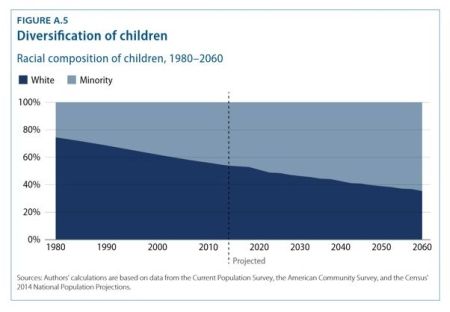WASHINGTON, March 4, 2015 – American politics will change drastically over the next two generations as the share of non-Hispanic white voters continues to shrink, according to authors of a report produced by three leading Washington think tanks. And while the rise of a non-white majority will be pronounced in Sun Belt and coastal states, even rural and farm-dependent states will not escape the change.
“The scale of race-ethnic transformation in the United States is stunning,” says the report, States of Change: The Demographic Evolution of the American Electorate, 1974-2060.
Its authors, William H. Frey of the centrist Brookings Institution and Ruy Teixeira and Robert Griffin of the liberal-leaning Center for American Progress, unveiled the report last week at a briefing at the more conservative American Enterprise Institute, which participated in the study. They and a panel of political experts ranging liberal to conservative agreed that the changes might not impose dramatic effects in the next couple of election cycles but that both major parties would need to accommodate the new population mix over time.
The U.S. population is down from 80 percent non-Hispanic white in 1980 to 63 percent today and the three demographers project it will be less than 44 percent in 2060. The Hispanic population share, at 6 percent in 1980, is 17 percent today and is seen reaching 29 percent 45 years from now. With African-Americans holding steady at 12-13 percent, Asians and others are expected to jump from just 8 percent today to 15 percent by 2060.
The political implications are evident in the rise of what the authors call “majority-minority” states in which non-Hispanic whites make up less than 50 percent. There are four such states now, Frey said: California, Hawaii, New Mexico and Texas. “But interestingly enough, another nine states are more than 40 percent minority,” he added. Those include states like Maryland and Georgia, a group that he described as “new Sun Belt and melting pot” states.
According to the projections, based on Census data, Frey expects that by 2040, “we have 13 states that are majority-minority. “By 2060 we have 22 states that are majority-minority, and another 20 states more than 40 percent. It is much more diverse when we look at the total over time.” Together, these 22 states account for about two-thirds of the country’s population. Frey said the racial and ethnic division of eligible voters “looks more or less the same.”
While the greatest shifts likely will be in “new melting pot” and Sun Belt states, Frey said, the Hispanic population also will increase in less populous and slower-growing Heartland states. “Different places at different paces,” he said.
The report concludes that diversity “is spreading everywhere: into new generations, into every age group – even seniors – and into every corner of the country, including such unlikely states as Oklahoma, Kansas and Utah.” The next 45 years will see “the graying of America,” Teixeira said, “but not white seniorization.” Instead, he said, it will be “the browning of the gray.”
 Frey anticipates a “big decline” in the white population share in Oklahoma – from 90 percent in 1980 to a slight majority-minority balance by 2045 and only 43 percent white by 2060.
Frey anticipates a “big decline” in the white population share in Oklahoma – from 90 percent in 1980 to a slight majority-minority balance by 2045 and only 43 percent white by 2060.
“Although whiter than Oklahoma, both Kansas and Nebraska have growing and sizable Hispanic populations that outnumber their existing black populations,” the report notes. It estimates that Kansas will be barely more than half white at 52 percent by 2050. “Nebraska, however, will diversify at a slower rate and should still be 64 percent white in 2060. Among the upper-tier Plains states, South Dakota is projected to experience the most change, with its white population declining from 84 percent to 61 percent from 2014 to 2060.” While Montana and the Dakotas are among the 10 whitest states, “minority populations in each of them are dominated by American Indians, and – as in most states – their small Hispanic populations are growing rapidly.”
Michigan, Wisconsin and Minnesota – 95-96 percent white in 1980 – are projected to be about 60 percent white in 2060. Iowa, described as the most rural and white Heartland Midwest state, can expect its white population share to drop off from 98 percent in 1980 to 71 percent by 2060 as Hispanics gain from less than 1 percent in 1980 to 6 percent today and 15 percent by 2060.
Emory University political scientist Alan Abramowitz said the report’s data portend “a growing racial divide between parties.” He and Teixeira said that the growing “millennial” generation and non-white voters overall tend to be more sympathetic to a wider role for government, a largely Democratic view, than older white voters who tend to vote Republican.
The growing Hispanic population – driven by fertility, not immigration, Teixeira said – will have an impact on national elections as early as 2016, according to other panelists. Former Secretary of State Hillary Clinton, if she is the Democratic nominee, “has an opportunity to eclipse 80 percent of the Latino vote,” said UCLA professor Matt Barreto. But former Florida Gov. Jeb Bush, should he win the GOP nomination, “has a significant opportunity to rebuild the Republican appeal to Latinos,” Barreto said, citing his Mexican-born wife and fluent Spanish.
#30
For more news, go to www.agri-pulse.com.

